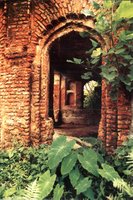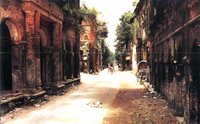 Sonargaon ruins |  Dulalpur bridge |
 Sonargaon (Panam Nagar) ruins |  Bangla bari |
 Sonakanda fort |  Tomb of Sultan Gyasuddin Azam Shah |
 Sonargaon Museum |  Kadam Rasul dargah at Nabiganj |
(pics: unknown websites)
Sonargaon (literal meaning ‘golden village’) was the capital of eastern Bengal under the Shahi Sultan rulers of Bengal during medieval age. It survives at present as a township about 27 kilometers southeast of Dhaka. It’s difficult to locate exactly the medieval city, but from the old remains it appears to encompass a wide tract bounded on the east, west and south by the Meghna, the Shitalakhya and the Dhaleshwari rivers respectively and on the north by the Brahmaputra.
With the annexation of the Muslim principality of Lakhnauti by Shamsuddin Firuz Shah in 14th century, Sonargaon became the seat of an independent ruler under son and successor Ghiyasuddin Bahadur Shah, and after his fall it became the headquarters of the eastern province of Bengal under the Tughlaqs till 1338. Sonargaon emerged as the capital of an independent Sultanate under Fakhruddin Mubarak Shah (1338-1349) and his son Ikhtiyaruddin Ghazi Shah (1349-1352).
By the second quarter of the 14th century, Sonargaon developed into a commercial metropolis. Seafaring boats reached Sonargaon from west Asian and southeast Asian countries. Ibn Batuta describes Sonargaon as an important port city which had direct commercial relations with countries like China, Indonesia (Java) and the Maldives. The Chinese envoy Hou hien (1415) describes it as a fortified walled city with tanks, streets and bazaars. Famous Muslin produced in Sonargaon, especially its finest variety called khasa, had a worldwide reputation.
Sonargaon developed into a seat of Islamic learning under the versatile scholar Maulana Sharfuddin Abu Tawwamah of Bokhara who came between 1282 and 1287. He established a khanqah and a madrasa wherein all branches of Islamic learning as well as secular sciences were taught and studied.
With the advent of the Mughals and establishment of capital at Dhaka, Sonargaon is thought to have fallen fast into decay. In the late nineteenth and early twentieth century Panam-Nagar was developed as a part of medieval Sonargaon. With the loss of political status in the second decade of the 17th century, Sonargaon gradually lost its commercial importance as well.
The existing remains now are a few medieval buildings, mostly religious, belonging to the Sultanate and Mughal periods, some Mughal bridges and a few residential buildings of the colonial period. The other remains are Sultan Ghiyasuddin Azam Shah’s Tomb at Shah Chilapur, Paanch Pir Dargah and Mosque at Bhagalpur, Sonakanda fort (17th century), Dewanbagh mosque (16th century) at Dewanbagh, and Kadam Rasul (1778-79) at Nabiganj.
Also see, Panam nagar and Sonargaon.
With the annexation of the Muslim principality of Lakhnauti by Shamsuddin Firuz Shah in 14th century, Sonargaon became the seat of an independent ruler under son and successor Ghiyasuddin Bahadur Shah, and after his fall it became the headquarters of the eastern province of Bengal under the Tughlaqs till 1338. Sonargaon emerged as the capital of an independent Sultanate under Fakhruddin Mubarak Shah (1338-1349) and his son Ikhtiyaruddin Ghazi Shah (1349-1352).
By the second quarter of the 14th century, Sonargaon developed into a commercial metropolis. Seafaring boats reached Sonargaon from west Asian and southeast Asian countries. Ibn Batuta describes Sonargaon as an important port city which had direct commercial relations with countries like China, Indonesia (Java) and the Maldives. The Chinese envoy Hou hien (1415) describes it as a fortified walled city with tanks, streets and bazaars. Famous Muslin produced in Sonargaon, especially its finest variety called khasa, had a worldwide reputation.
Sonargaon developed into a seat of Islamic learning under the versatile scholar Maulana Sharfuddin Abu Tawwamah of Bokhara who came between 1282 and 1287. He established a khanqah and a madrasa wherein all branches of Islamic learning as well as secular sciences were taught and studied.
With the advent of the Mughals and establishment of capital at Dhaka, Sonargaon is thought to have fallen fast into decay. In the late nineteenth and early twentieth century Panam-Nagar was developed as a part of medieval Sonargaon. With the loss of political status in the second decade of the 17th century, Sonargaon gradually lost its commercial importance as well.
The existing remains now are a few medieval buildings, mostly religious, belonging to the Sultanate and Mughal periods, some Mughal bridges and a few residential buildings of the colonial period. The other remains are Sultan Ghiyasuddin Azam Shah’s Tomb at Shah Chilapur, Paanch Pir Dargah and Mosque at Bhagalpur, Sonakanda fort (17th century), Dewanbagh mosque (16th century) at Dewanbagh, and Kadam Rasul (1778-79) at Nabiganj.
Also see, Panam nagar and Sonargaon.

No comments:
Post a Comment